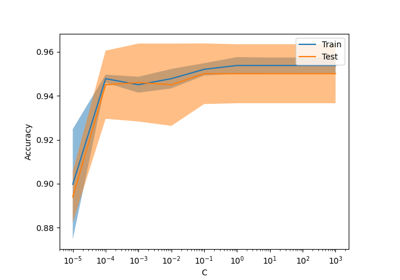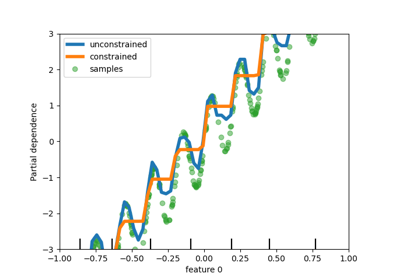注意
跳转到末尾 下载完整示例代码。或者通过 JupyterLite 或 Binder 在浏览器中运行此示例
scikit-learn 1.1 发布亮点#
我们很高兴地宣布 scikit-learn 1.1 发布!本次发布新增了许多错误修复和改进,以及一些新的关键功能。下面我们详细介绍此版本的一些主要功能。有关所有更改的详尽列表,请参阅发布说明。
安装最新版本(使用 pip)
pip install --upgrade scikit-learn
或使用 conda
conda install -c conda-forge scikit-learn
HistGradientBoostingRegressor 中的分位数损失#
HistGradientBoostingRegressor 可以通过 loss="quantile" 和新参数 quantile 对分位数进行建模。
import matplotlib.pyplot as plt
import numpy as np
from sklearn.ensemble import HistGradientBoostingRegressor
# Simple regression function for X * cos(X)
rng = np.random.RandomState(42)
X_1d = np.linspace(0, 10, num=2000)
X = X_1d.reshape(-1, 1)
y = X_1d * np.cos(X_1d) + rng.normal(scale=X_1d / 3)
quantiles = [0.95, 0.5, 0.05]
parameters = dict(loss="quantile", max_bins=32, max_iter=50)
hist_quantiles = {
f"quantile={quantile:.2f}": HistGradientBoostingRegressor(
**parameters, quantile=quantile
).fit(X, y)
for quantile in quantiles
}
fig, ax = plt.subplots()
ax.plot(X_1d, y, "o", alpha=0.5, markersize=1)
for quantile, hist in hist_quantiles.items():
ax.plot(X_1d, hist.predict(X), label=quantile)
_ = ax.legend(loc="lower left")
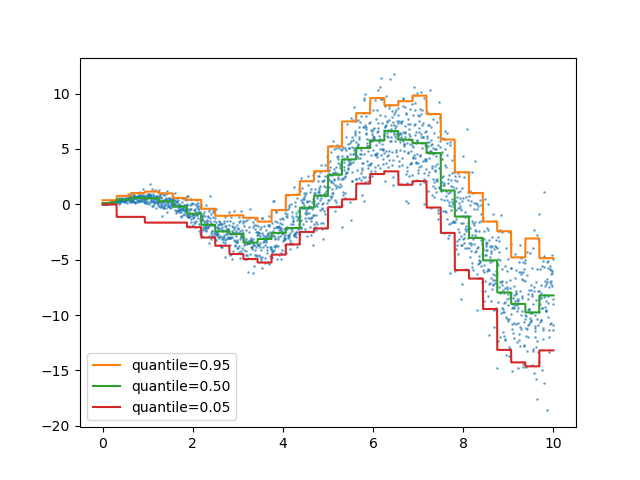
有关用例示例,请参阅直方图梯度提升树中的特征
所有 Transformer 中均可用的 get_feature_names_out#
get_feature_names_out 现已在所有 transformer 中可用,从而完成了 SLEP007 的实现。这使得 Pipeline 能够为更复杂的管道构建输出特征名称
from sklearn.compose import ColumnTransformer
from sklearn.datasets import fetch_openml
from sklearn.feature_selection import SelectKBest
from sklearn.impute import SimpleImputer
from sklearn.linear_model import LogisticRegression
from sklearn.pipeline import make_pipeline
from sklearn.preprocessing import OneHotEncoder, StandardScaler
X, y = fetch_openml(
"titanic", version=1, as_frame=True, return_X_y=True, parser="pandas"
)
numeric_features = ["age", "fare"]
numeric_transformer = make_pipeline(SimpleImputer(strategy="median"), StandardScaler())
categorical_features = ["embarked", "pclass"]
preprocessor = ColumnTransformer(
[
("num", numeric_transformer, numeric_features),
(
"cat",
OneHotEncoder(handle_unknown="ignore", sparse_output=False),
categorical_features,
),
],
verbose_feature_names_out=False,
)
log_reg = make_pipeline(preprocessor, SelectKBest(k=7), LogisticRegression())
log_reg.fit(X, y)
这里我们将管道切片以包含除最后一步之外的所有步骤。此管道切片的输出特征名称是输入到逻辑回归中的特征。这些名称直接对应于逻辑回归中的系数
import pandas as pd
log_reg_input_features = log_reg[:-1].get_feature_names_out()
pd.Series(log_reg[-1].coef_.ravel(), index=log_reg_input_features).plot.bar()
plt.tight_layout()
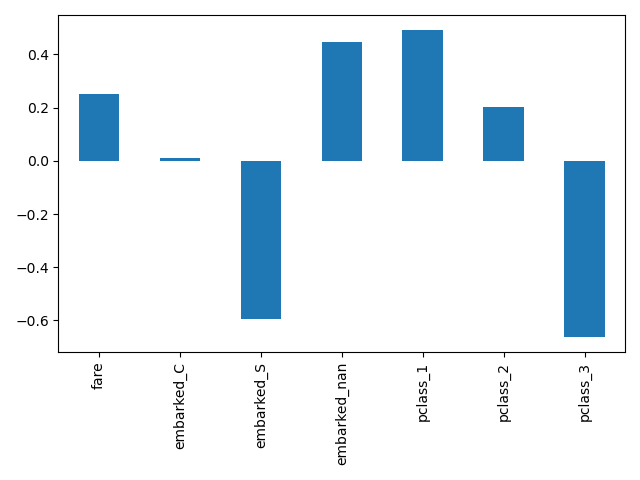
在 OneHotEncoder 中对不常见类别进行分组#
OneHotEncoder 支持将不常见类别聚合为每个特征的单个输出。用于启用不常见类别聚合的参数是 min_frequency 和 max_categories。有关更多详细信息,请参阅用户指南。
import numpy as np
from sklearn.preprocessing import OneHotEncoder
X = np.array(
[["dog"] * 5 + ["cat"] * 20 + ["rabbit"] * 10 + ["snake"] * 3], dtype=object
).T
enc = OneHotEncoder(min_frequency=6, sparse_output=False).fit(X)
enc.infrequent_categories_
[array(['dog', 'snake'], dtype=object)]
由于 dog 和 snake 是不常见的类别,它们在转换时被分组在一起
encoded = enc.transform(np.array([["dog"], ["snake"], ["cat"], ["rabbit"]]))
pd.DataFrame(encoded, columns=enc.get_feature_names_out())
性能改进#
密集 float64 数据集的成对距离计算已重构,以更好地利用非阻塞线程并行性。例如,neighbors.NearestNeighbors.kneighbors 和 neighbors.NearestNeighbors.radius_neighbors 分别比以前快 20 倍和 5 倍。总而言之,以下函数和评估器现在受益于改进的性能
要了解这项工作的技术细节,您可以阅读这系列博客文章。
此外,损失函数的计算已使用 Cython 重构,从而改进了以下评估器的性能
MiniBatchNMF:NMF 的在线版本#
新的类 MiniBatchNMF 实现了非负矩阵分解 (NMF) 的更快但精度较低的版本。MiniBatchNMF 将数据划分为 mini-batch,并通过循环遍历 mini-batch 以在线方式优化 NMF 模型,使其更适合大型数据集。特别是,它实现了 partial_fit,这可用于数据未从一开始就准备好或数据不适合内存时的在线学习。
import numpy as np
from sklearn.decomposition import MiniBatchNMF
rng = np.random.RandomState(0)
n_samples, n_features, n_components = 10, 10, 5
true_W = rng.uniform(size=(n_samples, n_components))
true_H = rng.uniform(size=(n_components, n_features))
X = true_W @ true_H
nmf = MiniBatchNMF(n_components=n_components, random_state=0)
for _ in range(10):
nmf.partial_fit(X)
W = nmf.transform(X)
H = nmf.components_
X_reconstructed = W @ H
print(
"relative reconstruction error: ",
f"{np.sum((X - X_reconstructed) ** 2) / np.sum(X**2):.5f}",
)
relative reconstruction error: 0.00364
BisectingKMeans:划分与聚类#
新的类 BisectingKMeans 是 KMeans 的变体,它使用分裂层次聚类。它不是一次性创建所有质心,而是根据先前的聚类逐步选择质心:一个簇被重复分裂成两个新簇,直到达到目标簇的数量,从而为聚类提供层次结构。
import matplotlib.pyplot as plt
from sklearn.cluster import BisectingKMeans, KMeans
from sklearn.datasets import make_blobs
X, _ = make_blobs(n_samples=1000, centers=2, random_state=0)
km = KMeans(n_clusters=5, random_state=0, n_init="auto").fit(X)
bisect_km = BisectingKMeans(n_clusters=5, random_state=0).fit(X)
fig, ax = plt.subplots(1, 2, figsize=(10, 5))
ax[0].scatter(X[:, 0], X[:, 1], s=10, c=km.labels_)
ax[0].scatter(km.cluster_centers_[:, 0], km.cluster_centers_[:, 1], s=20, c="r")
ax[0].set_title("KMeans")
ax[1].scatter(X[:, 0], X[:, 1], s=10, c=bisect_km.labels_)
ax[1].scatter(
bisect_km.cluster_centers_[:, 0], bisect_km.cluster_centers_[:, 1], s=20, c="r"
)
_ = ax[1].set_title("BisectingKMeans")
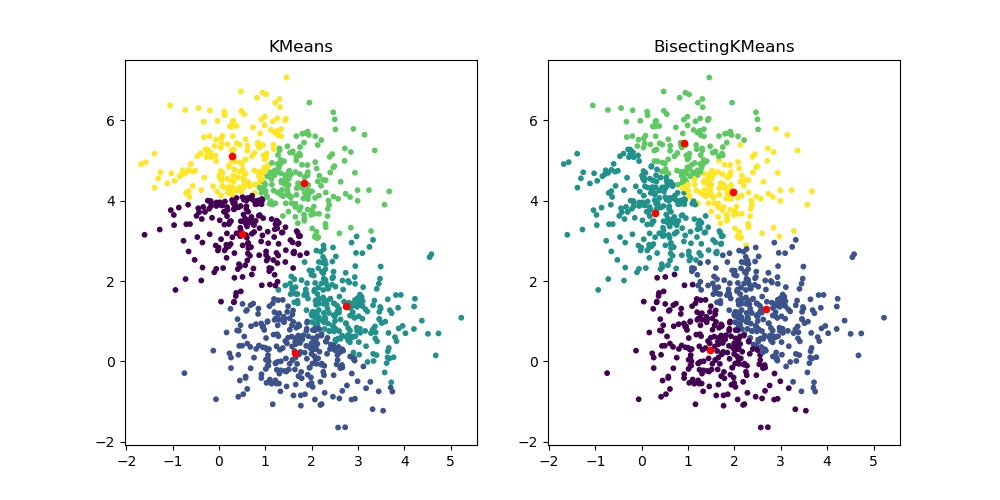
脚本总运行时间: (0 分钟 0.983 秒)
相关示例


